Uncovering Silhouette’s hidden utopia: Grande Barbe |25 February 2013

Residents of La Passe, the only main village on Silhouette, which flanks its eastern coastline, meet those gazes. La Passe boasts a beautiful long beach, warm local spirit, and six resident tortoises. However, it is what lies on the blind side of Silhouette – that so many eyes have never seen – that is arguably the island’s best-kept secret.
The seldom-visited Grande Barbe plateau runs almost parallel to La Passe, along Silhouette’s northwest coast. It is undoubtedly the most captivating part of the island, benefiting from the grandiose backdrop of Mount Dauban, the second highest peak in the country at 740m. Grande Barbe also exhibits one of the largest wetlands in Seychelles: a sprawling mangrove forest that provides an important refuge for an abundance of aquatic life. Likewise, a stunning 1km stretch of sand extends along the shore and provides the most important turtle-nesting beach on Silhouette.
The Island Conservation Society (ICS) makes frequent visits to Grande Barbe, in order to conduct turtle monitoring and tagging, and is currently piloting methods to map the wetland with GPS, and investigate the native mangrove species. The team consists of Benjamin Thompson, J-elle Perrine, and Rachel Kwok.
A La Passe fisherman is organised through the Islands Development Company to transport the team to and from the beach. The last two visits yielded an incredible 40 and 42 hawksbill turtle tracks, respectively. When visiting during the nesting season (November-March) and at high tide, the sight of females nesting is almost guaranteed. ICS measures the track width and mark the GPS location of each. Individual turtles are checked for tags and if not present, the team carefully tags each front flipper. Tagging allows the turtle’s course to be revealed by comparing tag numbers with historical (and future) records.
It is not just the natural, but the communal setting that makes Grande Barbe so distinctive. Once alleged to be bustling with some 60 former residents, today a population of just three occupies those buildings that remain standing. Paul Jerry, a former mason on Mahé, has recently moved to the village and is today responsible for landscaping and general maintenance of the plateau.
“I wanted to come here because it is quiet, and I would be happy to stay for as long as I can,” he said.
Mr Jerry told the ICS team that no one had visited since our last visit, some two weeks prior, emphasising Grande Barbe’s secluded disposition. Two other members of the community cited old age and a school closure as the prime reasons for the departure of their former neighbours. The trio is outnumbered by five wild tortoises, which help eradicate invasive vegetation. As such, the contrasting appearance of dilapidated buildings set among grazed greenery and well-kept communal spaces leaves visitors with a sense of surrealism.
Fringed by a barrier reef creating a rebellious sea, and with 4km of mountainous terrain separating it from La Passe, setting foot on Grande Barbe does not come easy. The rolling waves make mooring a boat challenging, and the only trail across the island is physically demanding. Trekking from La Passe to Grande Barbe involves crossing diverse environments, and provides an excellent opportunity to see Silhouette’s fauna and flora. Along the way exists a small shrine with a statue of the Virgin Mary, curiously positioned in the middle of the forest, while later, a grueling, sun-laden descent along baking slabs of syenite rock must be negotiated to reach the plateau. However, adventurers are well rewarded for their efforts: sharing an empty beach paradise with hawksbill turtles, and meeting a tiny community consisting predominantly of tortoises.
Benjamin Thompson
Silhouette conservation officer (ICS)







